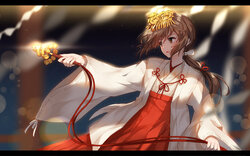Moegirlpedia would welcome your assistance in improving this article☆Kira~
As you read this article, you're welcome to participate in editing this page. Before editing, please read the wiki quickstart, editing guidelines and retrieve relevant information. We wish you a good time on Moegirlpedia. |
 Featured character: Mitsuha Miyamizu Pixiv ID: 60268880 | |
| Base Info | |
| Moe Point | Miko |
|---|---|
| Moe Point Synonyms | Shrine maiden |
| Type | Profession (religious) |
| Symbolic Characters | Reimu Hakurei, Rei Hino, Kikyo |
| Related Moe Points | priest/priestess |
A shrine maiden or miko (巫女、みこ) is a profession and a moe point in ACG subculture.
Introduction
It is a clergy occupation with a long history.
In several countries, mainly Asian countries, there are shrine maidens as a profession or position. The Japanese shrine maidens who have continued since modern times are the most well-known.
In other countries
Shrine maidens in China
Ancient Chinese shrine maidens, also called nuwu (女巫), wuzhu (巫祝), zhuzi (祩子) or zhushi (祝史), were the female officials in charge of rituals and ceremonies. It was said that they could subdue the gods through dancing, and were usually responsible for exorcising evil spirits, praying for rain and good weather. There were also shrine maidens who represented superstition and caused interference and even harm to productive activities. In "The Rule of Yeh by Ximen Bao" in the "Historical Records - Slippery Chronicles", it is recorded that shrine maidens drowned young women in rivers. Since the "total collapse" (礼崩乐坏) period, the number of shrine maidens has decreased due to the decay of Zhou rituals. Come the Han dynasty, after the rule of Confucianism, the rise of Taoism and the introduction of Buddhism, the number of shrine maidens in China, apart from those set aside by the royal family, had been reduced to a handful. After the rise of the Song dynasty, women's rights were further restricted, and the traditional Han Chinese profession of shrine maidens may have disappeared from existence.
Shrine maidens in Korea
In South Korea, they are called mudang (무당), or manshin (만신). Males are called baksu (박수). The baksu should wear women's clothing in the practice. They are divided into two types: séance maidens and hereditary maidens, and offered sacrifices to traditional Korean deities. During the Japanese Occupation period, they were forced to worship the gods of Japanese Shinto, such as Amaterasu. During the division of North and South Korea, the shrine maidens were regarded as confuses and banned, and were prohibited and suppressed by the two nations. In modern times, it was regarded by South Korea as a revival of its traditional culture.
Shrine maidens in Japan
Japanese shrine maidens, or miko ({{lj|
Until modern times, miko continued to be staff members of Japanese shrines. But modern miko no longer have a devout belief in gods, they have also lost their sacred status as a psychic medium, and are merely a profession. In modern times, there are no longer any strong restrictions or thresholds to becoming a miko. The work of a professional miko consists of performing rituals and dances at ceremonies, and requires the acquisition of appropriate skills. However, there are also part-time miko who work in shrines in their spare time to help with taking care of them. Shrines also recruit a large number of women as miko during festivals such as the first month of the year to cope with the increase of customer traffic and business.
Characters with this moe point
Shinto mikos
- Reimu Hakurei [Hakurei shrine], Sanae Kochiya [Moriya Shrine] (Touhou Project)
- Kagami Hiiragi, Tsukasa Hiiragi (Lucky Star)
- Rei Hino (Sailor Moon)
- Kikyo (Inuyasha)
- Nozomi Tojo (Love Live!) [Part-time maiden at the Kanda shrine]
- Rika Furude (Higurashi: When They Cry) [Furude Shrine]
- Himeko Kurusugawa (Kannazuki no Miko) [Priestess of the Sun]
- Chikane Himemiya (Kannazuki no Miko) [Priestess of the Moon]
- Risa Asakaze (Hayate the Combat Butler) [Asakaze Shrine]
- Akira Amatsume (Yosuga no Sora, Haruka na Sora) [Sayorihime Shrine]
- Luka Urushibara (Steins;Gate)
- Shirayuki Hotogi(Aria the Scarlet Ammo) [Shirayuki Shrine]
- Komaki Jindai (Saki) [Kirishima Shrine]
- Mitsuha Miyamizu] (Your Name.) [Miyamizu Shrine]
Other mikos
These are probably miko of another religion.
- Nakoruru (Samurai Shodown) [Ainu tribe]
- Kokoro (Princess Connect! Re:Dive)